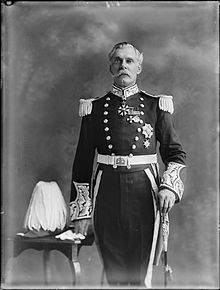John Dickson-Poynder, 1st Baron Islington
John Poynder Dickson Poynder, 1st Baron Islington Bt , GCMG , GBE , DSO , PC (* 31 October 1866 on the Isle of Wight ; † 6. December 1936 in Hyde Park in London) born when John Poynder Dickson was a British politician. He was Governor of New Zealand between 1910 and 1912 and later held senior positions in the British colonial administration in India.
Early life
He was born the son of Rear Admiral John Bourmaster Dickson on October 31, 1866 on the Isle of Wight and received his education at Twyford School , Harrow School and Christ Church in Oxford. In 1884 he inherited the title of 6th Baronet , of Hardingham Hall in the County of Norfolk, from a paternal uncle . After he took over the inheritance of a maternal uncle, he took his name "Poynder" in his surname with royal permission in 1888.
Member of Parliament
Dickson was appointed High Sheriff of Wiltshire in 1890 . He became a Member of Parliament for the Conservative Party in 1892 for the seat of the constituency of Chippenham in Wiltshire. In 1905 he joined the Liberal Party . From 1898 to 1904 he was a member of the London County Council . He served in the Second Boer War with the Royal Wiltshire Yeomanry (which acted as the Royal Scots' volunteer battalion ) as aide-de-camp for Lord Methuen . For these services he received the Distinguished Service Order (DSO) in November 1900 .
Governor of New Zealand
In 1910, Dickson was appointed governor of New Zealand under George V , a position he held from June 22, 1910 to December 3, 1912.
In the same year he was raised to Baron Islington , of Islington in the County of London . He was the last New Zealand governor to hold that title for his entire term. Due to the transition of New Zealand from the colony to the Dominion , which was already proclaimed by his predecessor, responsibility was transferred to a governor-general during the term of office of his successor. In 1911 he became Knight Commander of the Order of St. Michael and St. George (KCMG) and a member of the Privy Counsel , in 1912 he was appointed President of the Royal Commission for Public Service in India, in which he shared with Lord Ronaldshay , Herbert Fisher and Abdur Rahim worked together.
Further career
Dickson became Under-Secretary of State for the Colonies and Under-Secretary of State for India in 1915 . He chaired the Imperial Institute for eight years, as well as the National Savings Committee from 1920 to 1926 . In 1926 he was appointed Knight Grand Cross of the Order of the British Empire (GBE).
Dickson was married to Anne Dundas. With her he had a daughter, the Hon. Joan Alice Katherine Dickson-Poynder (1897-1987), who married Edward Grigg, 1st Baron Altrincham .
Lord Islington died on December 6, 1936 at the age of 70 in Hyde Park Gardens , London and was buried in Hilmarton , Wiltshire. Since he had no sons, both of his nobility titles expired upon his death.
Literature and web links
- Bernard John Foster: Islington, Sir John Poynder Dickson-Poynder, Bt., Baron; PC, GCMG, GBE, DSO, KJSt.J. In: Alexander Hare McLintock (Ed.): An Encyclopaedia of New Zealand . Wellington 1966 ( online [accessed December 15, 2015]).
- Sir John Dickson-Poynder at Hansard (English)
- John Poynder Dickson-Poynder, 1st and last Baron Islington on thepeerage.com
Individual evidence
- ^ A b Forster: Islington, Sir John Poynder Dickson-Poynder, ... In: An Encyclopaedia of New Zealand . 1966.
- ↑ London Gazette . No. 27359, HMSO, London, September 27, 1901, p. 6306 ( PDF , accessed October 20, 2013, English).
- ↑ Lord Islington, KCMG, DSO, PC . The Governor-General. Retrieved November 12, 2010.
- ^ Earl of Liverpool, GCB, GCMG, GBE, MVO, PC . The Governor-General. Retrieved November 12, 2010.
- ↑ London Gazette . No. 28642, HMSO, London, September 6, 1912, p. 6631 ( PDF , accessed October 20, 2013, English).
| predecessor | Office | successor |
|---|---|---|
| William Plunket, 5th Baron Plunket |
Governor of New Zealand 1910–1912 |
Arthur Foljambe, 2nd Earl of Liverpool |
| Alexander Dickson | Baronet, of Hardingham Hall 1884-1936 |
Title expired |
| New title created |
Baron Islington 1910-1936 |
Title expired |
| personal data | |
|---|---|
| SURNAME | Dickson-Poynder, John, 1st Baron Islington |
| ALTERNATIVE NAMES | Dickson-Poynder, John Poynder, 1st Baron Islington; Dickson, John Poynder; Dickson, Sir John, 6th Baronet |
| BRIEF DESCRIPTION | Politician, Governor of New Zealand and Colonial Administrator |
| DATE OF BIRTH | October 31, 1866 |
| PLACE OF BIRTH | Isle of Wight |
| DATE OF DEATH | December 6, 1936 |
| Place of death | London |

